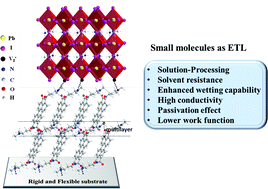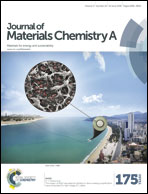New generation perovskite solar cells with solution-processed amino-substituted perylene diimide derivative as electron-transport layer†
Abstract
In this study, for the first time, we introduced amino-substituted perylene diimide derivative (N-PDI) as an alternative electron transport layer (ETL) to replace the commonly used TiO2 in planar heterojunction perovskite solar cells. Two types of device structures, i.e., glass/FTO/N-PDI/CH3NH3PbI3−xClx/spiro-MeOTAD/Au and polyethylene terephthalate PET/ITO/N-PDI/CH3NH3PbI3−xClx/spiro-MeOTAD/Au, were fabricated on both rigid and flexible substrates using room-temperature solution processing technique. Based on the proposed device structures, power conversion efficiency (PCE) of 17.66% was obtained based on glass/FTO rigid substrates, and a PCE of 14.32% was achieved based on PET/ITO flexible substrates. The results showed that the terminal amino group in N-PDI enhanced the wetting capability of the surfaces to perovskite, reduced the surface work function of the FTO substrate and passivated the surface trap states of the perovskite films. These results confirm that small molecule semiconductor N-PDI can serve as an effective electron-transport material for achieving high-performance perovskite solar cells and draw molecular design guidelines for electron-selective contacts with perovskite.



 Please wait while we load your content...
Please wait while we load your content...